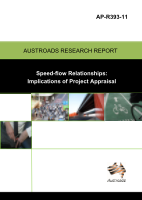Economics and Financing

Speed-flow Relationships: Implications of Project Appraisal
- Publication no: AP-R393-11
- ISBN: 978-1-921709-98-2
- Published: 23 September 2011
- PDF (free) Download
The project includes a literature review of speed-flow curves, review of practices across jurisdictions, implications of speed-flow curves for project appraisal, harmonisation of speed-flow curves. A range of speed-flow curve relationships is currently in use by road authorities across jurisdictions in Australia. These speed-flow relationships are used by these authorities in carrying out road project evaluations of mostly urban and, to a lesser degree, rural road projects in Australia.
The way some of these relationships are specified becomes more critical when volume-capacity ratios (VCR) approach and exceed a value of 1.0 because different queuing speeds are assumed at different VCR levels.
- 1. INTRODUCTION
- 1.1. Methodology
- 2. REVIEW OF LITERATURE AND CURRENT PRACTICE
- 2.1. Overview of Common Speed-flow Functions
- 2.2. Usage of Speed-flow Curves Internationally
- 2.2.1. UK Experience
- 2.2.2. Other European Experience
- 2.2.3. US Experience
- 2.2.4. World Bank Experience
- 2.3. Speed-flow Curves in Australia
- 2.3.1. Speed-flow Curves across Australian Jurisdictions
- 3. IMPLICATIONS OF SPEED-FLOW CURVES FOR ROAD PROJECT EVALUATION
- 3.1. Freeway On-ramp Example
- 3.2. Road Widening Example
- 4. FACILITATING ‘HARMONISATION’ OF SPEED-FLOW RELATIONSHIPS ACROSS JURISDICTIONS
- 4.1. A Representative Framework for Speed-flow Relationships
- 4.2. Jurisdiction Response on Issues about Harmonisation of Speed-flow Curve Relationships
- 4.2.1. Representation of Speed-flow (VCR-speed) Relationships as a Best Practice Framework
- 4.2.2. Desirability of Harmonisation of Speed-flow Curves and Appropriate Queuing Speeds across Jurisdictions
- 4.2.3. Attainment of Harmonisation of Speed-flow Relationships (Queuing Speeds) and Likely Obstacles
- 4.3. Austroads Evaluation and Planning Technical Review Panel Decision on Default Queuing Speed
- 5. CONCLUSIONS
- REFERENCES
- APPENDIX A SPEEDS, CAPACITIES AND LINK TYPES FOR SPEED-FLOW CURVES AT JURISDICTIONAL LEVEL
- APPENDIX B LEVEL OF SERVICE (LOS) DEFINITIONS AND CRITERIA AT DIFFERENT SPEEDS
Related publications
Latest Economics and Financing News
